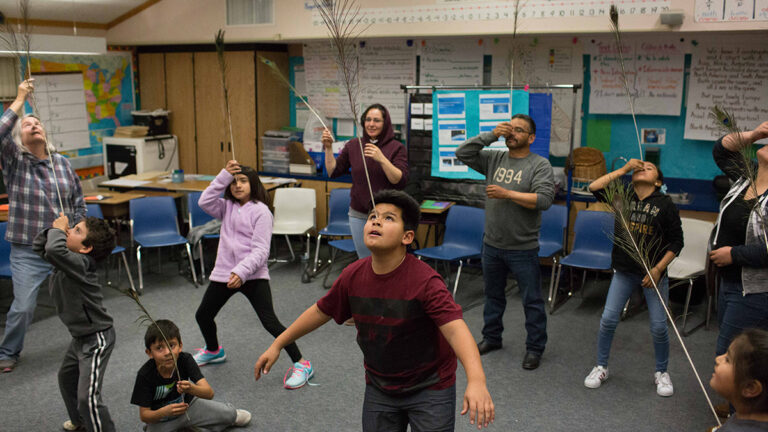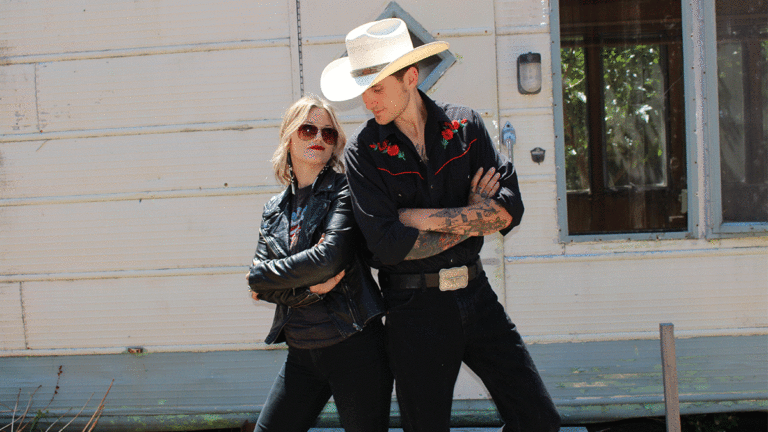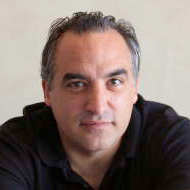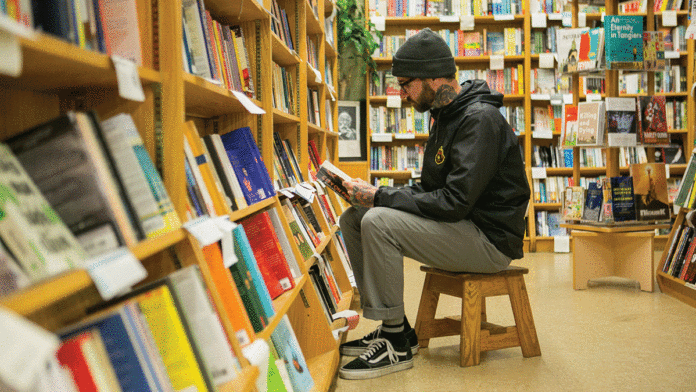Best Alternative Health Services
Santa Cruz Naturopathic
 Founded in 2009, Santa Cruz Naturopathic Medical Center is celebrating its ninth anniversary this year.
Founded in 2009, Santa Cruz Naturopathic Medical Center is celebrating its ninth anniversary this year.- Housed in an old Victorian in a quaint historic corner of downtown, there’s a homey and inviting feel to the waiting room and offices.
- Santa Cruz Naturopathic hosts four naturopathic medical doctors.
- The center specializes in hormone therapy as well as intravenous and vitamin injection therapy—a more direct delivery method for vitamins and nutrient supplements. On Wednesdays and Saturdays, the center hosts vitamin B12 Happy Hours, with discounted prices and several add-on options.
- SCNMC specializes in integrative and alternative holistic medicine for the whole family—men, women, children—so clients get care that can be integrated into current conventional treatment plans. MARIA GRUSAUSKAS
Best Book Store
Bookshop Santa Cruz
- Bookshop Santa Cruz is located in the same spot on Pacific Avenue as its spiritual forebear, the Hip Pocket bookstore, which was open for less than two years in the early 1960s. Among those who could regularly be found hanging out at the Hip Pocket—sometimes pulling a shift behind the cash register—was Jack Kerouac literary hero Neal Cassady.
- Bookshop’s first employee back in 1966 was Jon Scoville, accomplished composer and husband of celebrated dancer/choreographer Tandy Beal.
- The wooden rocking horse in Bookshop’s beautiful children’s books section has been the bookstore’s symbol going back four decades.
- That rocking horse was one of the first things rescued from the store’s damaged interior by then-owner Neal Coonerty after the 1989 Loma Prieta Earthquake.
- In the 2000s, Bookshop sold a Bush Countdown Clock, which tracked the number days, hours, minutes and seconds before George W. Bush left office. Today, Bookshop sells a similar Trump Countdown Clock. WALLACE BAINE
Best Flower Shop
Flower Shack
 In May, the Flower Shack will celebrate 30 years under the ownership of Cathy Britton.
In May, the Flower Shack will celebrate 30 years under the ownership of Cathy Britton.- The shop purchases all of their blooms locally, and works directly with flower growers in Watsonville.
- The Flower Shack is a full-service florist, including deliveries and weddings.
- One of their craziest orders the shop ever filled, says Britton, was when a woman discovered her husband had cheated on her. She decided to leave him and used his credit card to purchase everything in the shop. Britton says they had to close for the day because they had nothing left.
- In addition to the longtime storefront next to the Buttery on Branciforte Drive, the Flower Shack opened a second location in Pleasure Point on 41st Avenue last fall. LILY STOICHEFF
Best Hair Salon
L’Atelier
 L’Atelier means “the workshop” in French. It captures the artistic approach the stylists take, as well as the general Pearl Alley vibe.
L’Atelier means “the workshop” in French. It captures the artistic approach the stylists take, as well as the general Pearl Alley vibe.- With its inviting chalkboard messages regularly on view outside, the salon gets walk-ins every day. They encourage spontaneous visits.
- Dedicated to customer care, they provide in-depth consultations and customize each guest’s service for lifestyle and hair type.
- If you are one of 65 percent of people with curly hair, the salon can help you embrace the curls with a special cut called the DevaCut.
- L’Atelier is known among regular clients for its positive energy and family atmosphere. ANDREA PATTON
Best Headshop
Pipeline
 Pipeline is celebrating 40 years of providing the essential gear to the Santa Cruz cannabis community.
Pipeline is celebrating 40 years of providing the essential gear to the Santa Cruz cannabis community.- Last year, they opened up a wall that led to the back section, creating a more open setting in which to browse their large selection of glass and vaping supplies. With new cannabis laws, now customers have to be 21 to enter the back third of the store, though, instead of 18—and yes, they check. Visitors of all ages are welcome in the front portion of the store.
- Coral Reefers, a famous cannabis-loving YouTuber, makes art in the front part of the studio. You can watch her from Pacific Avenue through the glass windows.
- If discretion is your concern, Pipeline has you covered. They offer several herbal vaporizers for a smoke-free delivery of your favorite herb.
- Pipeline has been home to several generations of cats. Bowie and Sigmund are the latest felines to serve as the fuzzy, purring heart of the store. AP
Best Roofers
Knox Roofing
 Through their Roofs for Troops program, Knox Roofing gives veterans a $250 rebate, and it also supports the Boys and Girls Club.
Through their Roofs for Troops program, Knox Roofing gives veterans a $250 rebate, and it also supports the Boys and Girls Club.- The company works with several solar companies, including Independent Energy Systems and Allterra.
- Knox donated a new roof to the Scotts Valley Historical Society for its renovation of the Scott House, one of the oldest buildings in Scotts Valley.
- Sister company Knox Garden Box provides elevated (3 feet tall) garden boxes for easy access to plants, vegetables, or anything you can grow in 1-30 cubic feet of soil.
- The average roof lasts around 15-20 years. Signs that your roof is due for repair include a leak in the attic, blistering or peeling interior paint, and stains on interior ceilings or walls. AP
Adult Store
Pure Pleasure Shop
111 Cooper St., Santa Cruz,
466-9870, purepleasureshop.com
RUNNERS-UP Camouflage, Frenchy’s
Alternative Health Services
Santa Cruz Naturopathic Medical Center
736 Chestnut St., Santa Cruz
477-1377, scnmc.com
RUNNERS-UP Santa Cruz CORE Fitness, Thrive Natural Medicine
Antiques
Center Street Antiques
3010 Center St., Soquel
477-9211, centerstreetantiques.com
RUNNERS-UP Edwards and Sons Antiques, Wisteria Antiques and Design
Arts and Crafts
Palace Arts & Office Supply
1407 Pacific Ave., Santa Cruz, 427-1550,
1501 41st Ave., Capitola, 464-2700,
gopalace.com
RUNNERS-UP Art Supplies Ink, Lenz Arts
Auto Dealer (New)
Toyota of Santa Cruz
4200 Auto Plaza Drive, Capitola, 465-8600, santacruztoyota.com
RUNNERS-UP Ocean Honda, Subaru of Santa Cruz
Auto Dealer (Pre-Owned)
The Argus Company
905 Water St., Santa Cruz, 457-1900, thearguscompany.com
RUNNERS-UP Auto One, Toyota of Santa Cruz
Auto Repair
Lloyds Tire and Auto Care
303 River St., Santa Cruz, 426-4363, lloydstires.com
RUNNERS-UP Mick’s Automotive, Specialized Auto
Bank (Local)
Santa Cruz County Bank
7775 Soquel Drive, Aptos, 662-6000
819 Bay Ave., Capitola, 464-5300
720 Front St., Santa Cruz, 457-5000
4604 Scotts Valley Drive, # 10, Scotts Valley, 461-5000
RUNNERS-UP Lighthouse Bank
Bank (Credit Union)
Bay Federal Credit Union
Multiple Locations
RUNNERS-UP Santa Cruz Community Credit Union
Barbershop
Montgomery’s Barber Shop
1047 Water St., Santa Cruz, 713-5038
RUNNERS-UP Live Oak, West Side Barbershop
Bed & Breakfast
Inn at Depot Hill
250 Monterey Ave., Capitola, 462-3376, innatdepothill.com
RUNNERS-UP Babbling Brook Inn, Monarch Cove Inn
Beauty Supply
Westside Beauty Supply
Multiple Locations
RUNNER-UP Olympia Beauty Supply & Salon
Bookshop (new)
Bookshop Santa Cruz
1520 Pacific Ave., Santa Cruz, 423-0900, bookshopsantacruz.com
RUNNERS-UP Kelly’s Books, The Baytree Bookstore
Bookshop (used)
Goodwill Central Coast – Bookstore
815 Soquel Ave., Santa Cruz, 427-2005, ccgoodwill.org
RUNNERS-UP Bookshop Santa Cruz, The Literary Guillotine
Butcher
Shopper’s Corner
622 Soquel Ave., Santa Cruz, 423-1398, shopperscorner.com
RUNNERS-UP El Salchichero, Deluxe Foods, Freedom Meat Locker
Car Wash
Whalers Car Wash
2001 Soquel Ave., Santa Cruz, 423-0676, whalerscarwash.com
RUNNERS-UP Cruz Car Wash, Master Car Wash
Carpet Cleaning
Connoisseur
1521 Seabright Ave., Santa Cruz, 476-9721, santacruzclean.com
RUNNER-UP Cesar’s Cleaning, Quality Carpet Care
Children’s Day Care
Coastal Community Preschool
900 High St., Santa Cruz, 462-5437, coastalcommunitypreschool.org
RUNNERS-UP Happy Days, Simcha Preschool
Computer Repair
ClickAway
303 Potrero St., Santa Cruz, 420-1200, clickaway.com
RUNNERS-UP Abacus Computer Repair, Affordable Computer Repair
Consignment Clothing
Closet Shopper
504 Front St., Santa Cruz,
427-0400, theclosetshoppersantacruz.com
RUNNERS-UP Crossroads Trading Co., Jet Set Bohemian
Coworking Space
NextSpace
101 Cooper St., Santa Cruz, 420-0710, nextspace.us
RUNNERS-UP Cruzioworks, The Satellite
Custom Framing
Santa Cruz Picture Framing
1430 Soquel Ave., Santa Cruz, 423-8029, santacruzpictureframing.com
RUNNERS-UP Frame Circus, Lenz Arts
Dry Cleaners
Mission Dry Cleaners
1224 Mission St., Santa Cruz, 426-4226
RUNNERS-UP Almar Cleaners, Del Mar Cleaners
DVD Rental
Westside Video
2334 Mission St., Santa Cruz,
458-0134
RUNNERS-UP Capitola Video, DVD To Go
Eyewear
EyeQ
1101 Pacific Ave., Santa Cruz,
466-3937, eyeqsantacruz.com
RUNNERS-UP Midtown Optometry, Spex
Fabric
Harts Fabric
1620 Seabright Ave., Santa Cruz,
423-5434, hartsfabric.com
RUNNERS-UP Crossroad Fabrics, Judy’s Sewing and Vacuum Center
Feed Store
Mountain Feed & Farm Supply
9550 Hwy. 9, Ben Lomond,
336-8876, mountainfeed.com
RUNNERS-UP Scotts Valley Feed, Westside Farm and Feed
Financial Planner
Christine McBroom / Lanai Financial Solutions
1066 41st Ave a101, Capitola,
476-7300, lanaifinancialsolutions.com
RUNNERS-UP Cheryl Rebottaro, Kyle Sharp
Flooring
Bay Area Floors
2617 41st Ave., Soquel
662-3000, bay-area-floors.com
RUNNERS-UP Interior Vision, San Lorenzo Floors
Flower Shop
The Flower Shack
614 S Branciforte Ave., Santa Cruz, 423-3877
RUNNERS-UP The Bonny Doon Garden Company, Santa Cruz Floral
Free Wifi
Verve Coffee Roasters
1010 Fair Ave., Santa Cruz, 431,6547,
1540 Pacific Ave., Santa Cruz, 600-7784,
104 Bronson St., Santa Cruz, 471-8469,
Vervecoffee.com
RUNNERS-UP Abbott Square, Ugly Mug
Furniture
SC41
2647 41st Ave., Soquel,
464-2228, sc41.com
RUNNERS-UP Couch Potato, Sweets Wood Furniture
Garden Supply
Dig Gardens
420 Water St., Santa Cruz,
466-3444, diggardens.com
RUNNERS-UP Garden Company, San Lorenzo Garden Supply
Gift Shop
Zinnia’s Gift Boutique
Graham Plaza, 219 Mount Hermon Road, Scotts Valley,
430-9466, zinniasgiftboutique.com
RUNNERS-UP BaronHook Boutique, Outside-In
Green Business
Greenspace
719 Swift St., Santa Cruz,
423-7200, greenspacecompany.com
RUNNERS-UP Eco Goods, L’Atelier Salon
Grocery Store (local)
Shopper’s Corner
622 Soquel Ave., Santa Cruz,
423-1398, shopperscorner.com
RUNNERS-UP Deluxe Foods, Scotts Valley Market
Grocery Store (natural)
New Leaf Community Markets
1101 Fair Ave., Santa Cruz, 426-1306
1134 Pacific Ave., Santa Cruz, 425-1793
1210 41st Ave., Capitola, 479-7987
RUNNERS-UP Aptos Natural Foods, Staff of Life
Hair Salon
L’Atelier
114 Pearl Alley, Santa Cruz
423-4247, lateliersalon.com
RUNNERS-UP Lavish, The Nook
Hardware Store
Ace Hardware
1214 Soquel Ave., Santa Cruz, 457-2222
72 Rancho Del Mar, Aptos, 662-0222
849 Almar Ave., Santa Cruz, 426-7650
RUNNERS-UP San Lorenzo Lumber, Scarborough Lumber
Headshop
Pipeline
818 Pacific Ave., Santa Cruz,
425-7473, pipesinthecity.com
RUNNERS-UP Needful Things, Puff n Pass
Home Decorating
Dig Gardens
420 Water St, Santa Cruz,
466-3444, diggardens.com
RUNNERS-UP Botanic & Luxe, Stripe
Hotel
Dream Inn
175 W Cliff Drive, Santa Cruz,
426-4330, dreaminnsantacruz.com
RUNNERS-UP Hotel Paradox, Sea and Sand
House Cleaner
Sunrise Cleaning Service
332-1909, sunriseclean.com
RUNNERS-UP Christi’s Green Cleaning, Maria Garcia
House Painter
T Paul Sek Eco-Friendly Painting
721 Seabright Ave., Santa Cruz,
588-4080, greenpaintingcontractor.com
RUNNERS-UP Andson Painting, Spectrum
Hydroponic Supplier
The Grow Biz
2450 17th Ave., #100, Santa Cruz, 475-9900
thegrowbiz.com
RUNNER-UP Global Garden Supply
Internet Service Provider
Cruzio
877 Cedar St. #150, Santa Cruz,
459-6301, cruzio.com
RUNNER-UP Got.Net
Jewelry
Dell Williams
1320 Pacific Ave., Santa Cruz,
423-4100, dellwilliams.com
RUNNERS-UP Amory Body Arts, Artisans Gallery
Kids’ Clothing
Jelli Beanz
2555 Soquel Drive, Santa Cruz,
462-6700, jellibeanzonline.com
RUNNERS-UP Childish, Hopscotch
Kitchen Store
Toque Blanche
1527 Pacific Ave., Santa Cruz,
426-1351, mytoque.com
RUNNER-UP Outside-In
Landscaper
Dreamscape Creative Landscape Solutions
1916 Encina Drive, Santa Cruz
476-6800, dreamscape-cls.com
RUNNERS-UP K&D Landscaping, Paradise Landscape
Laser Hair Removal
Laser Hair and Skin Solutions
783 Rio Del Mar Blvd., #71b, Aptos, 689-9830
RUNNERS-UP Monterey Bay Laser Aesthetics, UltraDerm
Laundromat
Sudz
7887 Soquel Drive, Santa Cruz, 688-7839
709 Lighthouse Ave., Santa Cruz, 324-4920
RUNNERS-UP Bubbles, Seabright Laundromat, Seaside Wash & Dry
Lawyer
Carmela Woll
765 Cedar St. #202, Santa Cruz,
471-7458, carmelawoll.com
RUNNERS-UP Ben Rice, Brady Law
Life Coach
Bernadine Rosso
http://4stages4agracefuldivorce.com
RUNNERS-UP Karin Leonard, Jennifer Turner-Davis
Lighting
Riverside Lighting & Electric
300 Soquel Ave., Santa Cruz,
423-7411, riversidelightingandelectric.com
RUNNERS-UP Illuminée, Om Gallery
Lingerie
Camouflage
1329 Pacific Ave., Santa Cruz,
423-7613, shopcamouflage.com
RUNNERS-UP Amoureuse, Legs
Mani/Pedi
Opal Spa & Boutique
1066 41st Ave. A103, Capitola,
854-2434, opalspacapitola.com
RUNNERS-UP JC Nails, Oasis Hair and Skin
Massage School
Cypress Health Institute School of Massage
1119 Pacific Ave., Ste. 300, Santa Cruz,
476-2115, cypresshealthinstitute.com
RUNNER-UP Five Branches University
Men’s Clothing
Stripe Men
107 Walnut Ave., Santa Cruz,
421-9252, stripedesigngroup.com
RUNNER-UP Berdels
Men’s Shoes
Sockshop & Shoe Company
1515 Pacific Ave., Santa Cruz,
429-6101, sockshopandshoeco.com
RUNNERS-UP Beck’s, Old School Shoes
Music Instruction
Santa Cruz Children’s Chorus
facebook.com/santacruzchildrenschorus
RUNNERS-UP Music Together, Rhan Wilson
Musical Instruments
The Starving Musician
1003 Pacific Ave., Santa Cruz
426-1975, starvingmusician.com
RUNNERS-UP Thomas Musical Instruments, Ukuleles of Felton
Pet Grooming
The Whole Kitten Capoodle
1720 Commercial Way, Santa Cruz,
454-8311, kittencapoodle.com
RUNNERS-UP Animal House, The Dog Tub
Pet Sitting
GoDogz
818-3365, godogz.com
RUNNERS-UP Little Pup Lodge, Woofpack 831
Pet Store
Pet Pals
3660 Soquel Drive, Soquel,
464-8775, petpals.com
RUNNERS-UP Aptos Feed & Pet Supply, Scotts Valley Feed
Pharmacy
Westside Pharmacy
1401 Mission St., Santa Cruz,
423-7175, westsidepharmacyrx.com
RUNNERS-UP Frank’s, Horsnyder
Photo Developing
Bay Photo Lab
715 Soquel Ave., Santa Cruz, 425-1100
2959 Park Ave., Soquel, 475-6090
900 Disc Drive, Scotts Valley, 475-6686, bayphoto.com
Piercing Studio
Amory Body Arts
1720 Brommer St, Santa Cruz
600-7801
RUNNERS-UP Mission Street Tattoo & Piercing, Staircase
Plumbing
Bellows Plumbing, Heating & Air
2562 Research Park Drive, Soquel,
219-8644, bellowsservice.com
RUNNERS-UP Expert Plumbing, Tino’s Plumbing
Produce
Farmers Markets
RUNNERS-UP New Leaf Community Markets, Sunnyside Produce
Real Estate Agency
Coldwell Banker
824 B Mission St., Santa Cruz,
469-8000, coldwellbanker.com
RUNNERS-UP Bailey Properties, Sereno Group
Real Estate Agent
Lauren Spencer, My Santa Cruz Real Estate
7979 Soquel Drive, Aptos, 662-6522
RUNNERS-UP Gretchen Bach, David Lyng
Record / CD Store
Streetlight Records
939 Pacific Ave., Santa Cruz,
421-9200, streetlightrecords.com
RUNNERS-UP MetaVinyl, Undefeated Records
Roofers
Knox Roofing
46 El Pueblo Road, Scotts Valley,
461-0634, knoxroofing.com
RUNNERS-UP Daddario Roofing, Moriarity’s Roofing
Senior Home Care
ComForCare
100 Doyle St., #F, Santa Cruz,
427-1553, comforcare.com/california/santa-cruz-county
RUNNERS-UP Lifespan, Visiting Angels
Senior Residential Community
Dominican Oaks
3400 Paul Sweet Road, Santa Cruz,
462-6257, dominicanoaks.com
RUNNERS-UP Aegis, Sunshine Villa
Sign Shop
Stokes Signs
303 Potrero St., Santa Cruz,
426-1570, stokessigns.com
RUNNERS-UP Santa Cruz Signs, Signs Up
Solar Company
Allterra Solar
207 McPherson St., Santa Cruz,
425-2608, allterrasolar.com
RUNNERS-UP Sandbar Solar & Electric, Solar Technologies
Tanning
Glimmer & Glow
153 S. Morrissey Ave., Santa Cruz, 469-4569
266-L Mt. Hermon Road, Scotts Valley, 471-8201,
glimmerandglow.com
RUNNERS-UP Paradise Tanning Co., Tan
Tattoo Studio
Mission Street Tattoo
1515 Mission St., Santa Cruz,,
466-9417, mission-street-tattoo.com
RUNNERS-UP Good Omen Tattoo, O’Reilly’s Tattoo
Thrift Store
Goodwill Central Coast
350 Encinal St., Santa Cruz,
423-8611, ccgoodwill.org
RUNNERS-UP Abbot’s Thrift, Caroline’s Non Profit Thrift Shop
Tires
Lloyd’s Tires
303 River St., Santa Cruz,
426-4363, lloydstire.com
RUNNER-UP Dixon & Son Tires
Toy Store (kids)
Childish
1127 Soquel Ave., Santa Cruz,
454-8208, childishsantacruz.com
RUNNER-UP Wonderland
Veterinarian
Adobe Animal Hospital
1600 Soquel Drive, Santa Cruz,
462-5293, adobevets.com
RUNNERS-UP Scotts Valley Vet, Soquel Creek Animal Hospital
Video Game Shop
Level Up
113 Locust St., Santa Cruz, 295-6329
RUNNERS-UP GameStop, Mythic Games
Vintage Clothing
Moon Zooom
813 Pacific Ave., Santa Cruz, 423-8500
RUNNERS-UP Cognito Clothing, Tomboy
Waxing
European Wax Center
1955 41st Ave., Capitola,
477-9331, waxcenter.com
RUNNERS-UP Smooth Body Lounge, Waxing by Madison
Women’s Clothing
Pacific Trading Company
1224 Pacific Ave., Santa Cruz, 423-3349,
504 Bay Ave., Capitola, 476-6109, pacifictradingonline.com
RUNNERS-UP Aptos Shoes & Apparel, Stripe
Women’s Shoes
Sock Shop
1515 Pacific Ave., Santa Cruz,
429-6101, sockshopandshoeco.com
RUNNERS-UP Aptos Shoes & Apparel, Bunny’s Shoes


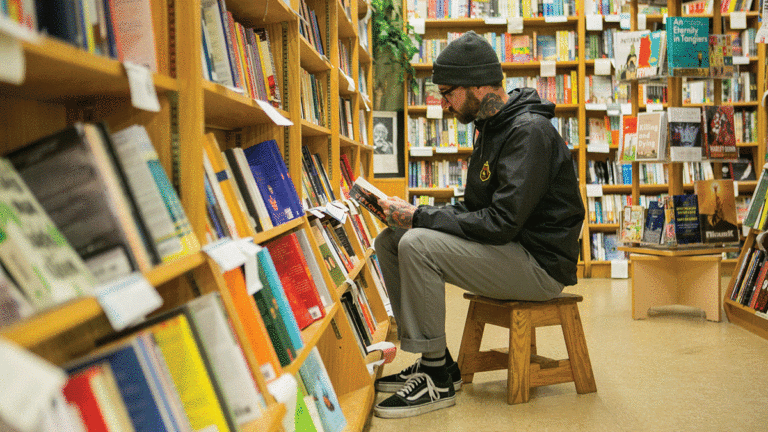
 Founded in 2009, Santa Cruz Naturopathic Medical Center is celebrating its ninth anniversary this year.
Founded in 2009, Santa Cruz Naturopathic Medical Center is celebrating its ninth anniversary this year. In May, the Flower Shack will celebrate 30 years under the ownership of Cathy Britton.
In May, the Flower Shack will celebrate 30 years under the ownership of Cathy Britton. L’Atelier means “the workshop” in French. It captures the artistic approach the stylists take, as well as the general Pearl Alley vibe.
L’Atelier means “the workshop” in French. It captures the artistic approach the stylists take, as well as the general Pearl Alley vibe. Pipeline is celebrating 40 years of providing the essential gear to the Santa Cruz cannabis community.
Pipeline is celebrating 40 years of providing the essential gear to the Santa Cruz cannabis community. Through their Roofs for Troops program, Knox Roofing gives veterans a $250 rebate, and it also supports the Boys and Girls Club.
Through their Roofs for Troops program, Knox Roofing gives veterans a $250 rebate, and it also supports the Boys and Girls Club.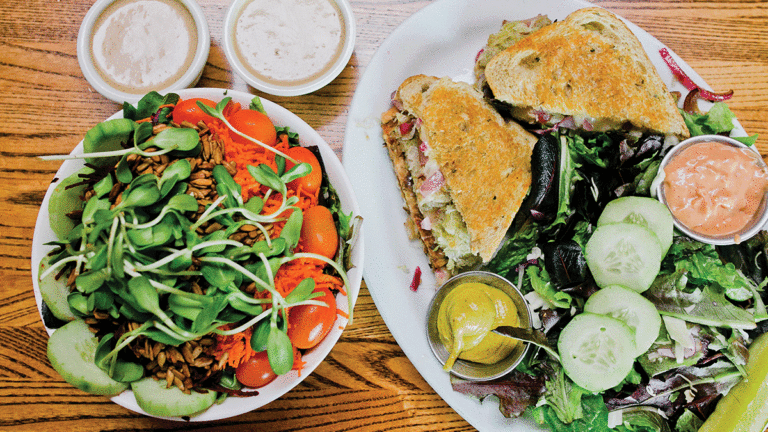
 Companion was founded in 2006 by self-taught baker Erin Lampel, opened its Westside location in 2010, and now has about 30 employees.
Companion was founded in 2006 by self-taught baker Erin Lampel, opened its Westside location in 2010, and now has about 30 employees. Breakfast is served all day; they are most famous for “The Hungry One” breakfast that includes three pancakes; two eggs any style; a choice of bacon, sausage, or ham; and potatoes.
Breakfast is served all day; they are most famous for “The Hungry One” breakfast that includes three pancakes; two eggs any style; a choice of bacon, sausage, or ham; and potatoes. In Spanish, the word “burrito” means “little donkey,” and there are multiple theories as to the exact origin of the food item and how it got its name.
In Spanish, the word “burrito” means “little donkey,” and there are multiple theories as to the exact origin of the food item and how it got its name. The owners of the Capitola fixture continue to modernize and renovate the restaurant’s one-of-a-kind atmosphere, staying current while retaining a classic feel.
The owners of the Capitola fixture continue to modernize and renovate the restaurant’s one-of-a-kind atmosphere, staying current while retaining a classic feel. It is still operated by the Zoccoli family, now in its third generation of owners, making it one of the oldest family-run businesses in all of Santa Cruz.
It is still operated by the Zoccoli family, now in its third generation of owners, making it one of the oldest family-run businesses in all of Santa Cruz. Quick primer on a falafel wrap: it’s basically a vegetarian Middle Eastern sandwich in a pita featuring falafel balls—which are made of fried chickpeas and spices—along with tahini sauce and vegetables.
Quick primer on a falafel wrap: it’s basically a vegetarian Middle Eastern sandwich in a pita featuring falafel balls—which are made of fried chickpeas and spices—along with tahini sauce and vegetables. The most popular menu items are gyros and souvlaki plates (grilled meats, salad, rice, pita, and tzatziki), and they also offer gluten-free and vegan items as well.
The most popular menu items are gyros and souvlaki plates (grilled meats, salad, rice, pita, and tzatziki), and they also offer gluten-free and vegan items as well. The restaurant’s name comes from a combination of Capitola and Soquel—two villages which back in 1929 flirted with the idea of merging townships.
The restaurant’s name comes from a combination of Capitola and Soquel—two villages which back in 1929 flirted with the idea of merging townships. Not much has changed in the décor or on the menu at Cassidy’s since it first opened in 1970—and loyal customers like it that way.
Not much has changed in the décor or on the menu at Cassidy’s since it first opened in 1970—and loyal customers like it that way.
 On the first and third Monday of the month, students can sign up for the advanced hip-hop class “Monday Madness,” where a rotating cast of distinguished guest instructors teach choreography.
On the first and third Monday of the month, students can sign up for the advanced hip-hop class “Monday Madness,” where a rotating cast of distinguished guest instructors teach choreography. Laura Ellen Hopper, who created the quirky country station 30 years ago as the spiritual successor to KFAT, was among the recipients of the first-ever Gail Rich Awards in 1997. Hopper is credited with popularizing the Americana genre.
Laura Ellen Hopper, who created the quirky country station 30 years ago as the spiritual successor to KFAT, was among the recipients of the first-ever Gail Rich Awards in 1997. Hopper is credited with popularizing the Americana genre.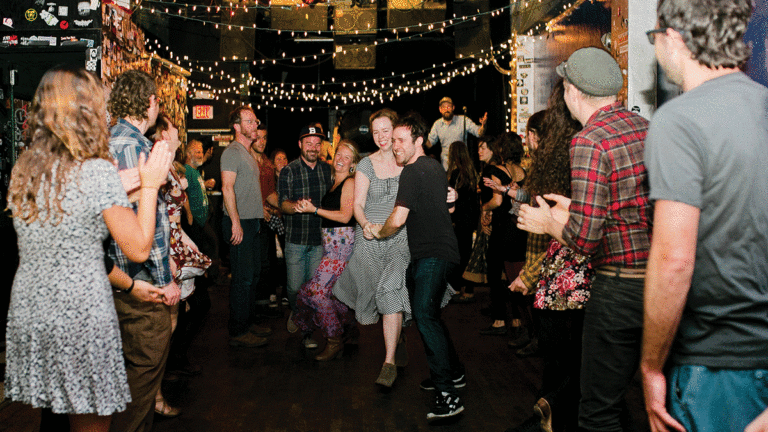
 This unpretentious, no-nonsense dive bar in downtown Soquel just celebrated its 30th anniversary as JJ’s Saloon, named for co-owners Joe and Judy Vierra, the latter of whom still presides over the bar.
This unpretentious, no-nonsense dive bar in downtown Soquel just celebrated its 30th anniversary as JJ’s Saloon, named for co-owners Joe and Judy Vierra, the latter of whom still presides over the bar. This retro saloon is housed in a restored vintage office building on the site of the city’s original Wells Fargo stagecoach stop.
This retro saloon is housed in a restored vintage office building on the site of the city’s original Wells Fargo stagecoach stop. Fast Eddy’s gets its name from the main character of the 1961 film
Fast Eddy’s gets its name from the main character of the 1961 film 
 Electronic bike sales have more than doubled in the past year.
Electronic bike sales have more than doubled in the past year. The toughest hole on DeLaveaga’s 18-hole course is the notorious 10th hole, a 590-yard monster par-5 with little room for error on its narrow fairway.
The toughest hole on DeLaveaga’s 18-hole course is the notorious 10th hole, a 590-yard monster par-5 with little room for error on its narrow fairway. Luma Yoga has had more than 95,000 studio visits since opening in 2012.
Luma Yoga has had more than 95,000 studio visits since opening in 2012.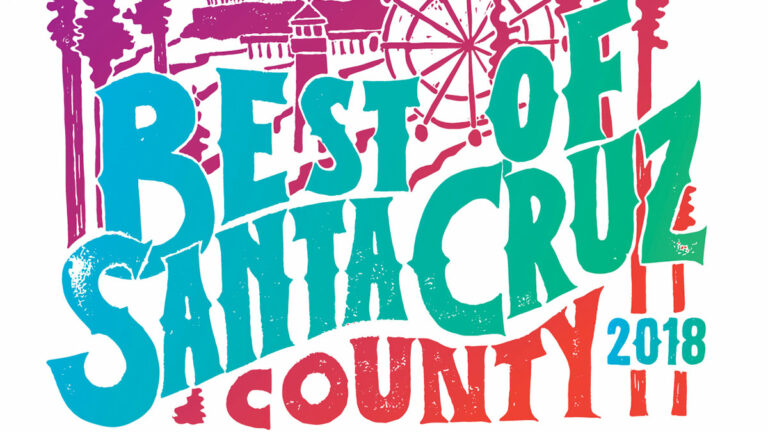
 Opened in May of 2017, this brand new collective is one part workspace and one part storefront, located on the main drag of Soquel Village. Owned by florist and designer Julie Martin of Willi Wildflower, Craftsmen Collective sells and promotes the work of 11 female artisans. A workspace toward the back of the store currently houses the antique printing press rescued from antiquity by Lauren Rhodes of the custom letterpress outfit Waldo Press. Martin says they’re looking for another artist, or maybe even two (inquire within or on their website—being male is not a deal-breaker). The storefront is a living, breathing (thanks to a variety of lush houseplants) oasis filled with quality, handcrafted jewelry, furniture, perfumes and body care products, woven baskets and textiles, glassware, ceramics and more. As if that’s not enough, the walls are studded with a killer selection of vintage bags. This is the one-stop-shop to find gifts and home decor while supporting local female artists. Workshops are offered regularly—check the website,
Opened in May of 2017, this brand new collective is one part workspace and one part storefront, located on the main drag of Soquel Village. Owned by florist and designer Julie Martin of Willi Wildflower, Craftsmen Collective sells and promotes the work of 11 female artisans. A workspace toward the back of the store currently houses the antique printing press rescued from antiquity by Lauren Rhodes of the custom letterpress outfit Waldo Press. Martin says they’re looking for another artist, or maybe even two (inquire within or on their website—being male is not a deal-breaker). The storefront is a living, breathing (thanks to a variety of lush houseplants) oasis filled with quality, handcrafted jewelry, furniture, perfumes and body care products, woven baskets and textiles, glassware, ceramics and more. As if that’s not enough, the walls are studded with a killer selection of vintage bags. This is the one-stop-shop to find gifts and home decor while supporting local female artists. Workshops are offered regularly—check the website,  When in search of towering waterfalls, there’s no need to go to the Sierra Nevada or up to Oregon. An 11-mile loop through Big Basin Redwoods State Park will take you past the towering Berry Creek Falls and a few other massive falls just upstream. This walk also takes hikers along gorgeous creeks, through beautiful sunny clearings and into the county’s impressive old-growth preserve. It’s no secret that most of the county’s redwood forests were logged a little more than a decade ago, so thank goodness for Big Basin, which happens to be California’s original state park. Its 18,000 acres just outside Boulder Creek are the difference between our region having quite a few ancient giants and having very few.
When in search of towering waterfalls, there’s no need to go to the Sierra Nevada or up to Oregon. An 11-mile loop through Big Basin Redwoods State Park will take you past the towering Berry Creek Falls and a few other massive falls just upstream. This walk also takes hikers along gorgeous creeks, through beautiful sunny clearings and into the county’s impressive old-growth preserve. It’s no secret that most of the county’s redwood forests were logged a little more than a decade ago, so thank goodness for Big Basin, which happens to be California’s original state park. Its 18,000 acres just outside Boulder Creek are the difference between our region having quite a few ancient giants and having very few.  This place appeases the curious, but is not for the faint of heart. If the stunning display of snakes and lizards doesn’t grab your attention, Jeffery, their 100-plus pound Asian water monitor lizard, will. The awe doesn’t stop at the reptiles, as they have some impressive sea anemones, silkworms, and a dog named Fish. The business is a family affair—owners Aaron and Brandyn are always hanging around the shop with their kids, willing to talk about all things fishy and slimy. Even if you’re not a pet owner, it’s well worth a stop in to take a gander at this wild bunch.
This place appeases the curious, but is not for the faint of heart. If the stunning display of snakes and lizards doesn’t grab your attention, Jeffery, their 100-plus pound Asian water monitor lizard, will. The awe doesn’t stop at the reptiles, as they have some impressive sea anemones, silkworms, and a dog named Fish. The business is a family affair—owners Aaron and Brandyn are always hanging around the shop with their kids, willing to talk about all things fishy and slimy. Even if you’re not a pet owner, it’s well worth a stop in to take a gander at this wild bunch.  The cheese section at Deluxe Foods of Aptos is epic, a portal to cheese-lovers’ fantasies that features products from Italy, Finland, Denmark, France and many other exotic ports of fromage. Need a good English cheddar infused with Irish Whisky? Don’t we all? It’s here! Deluxe doesn’t scrimp on excellent California cheese either (may we suggest Humboldt Fog goat cheese?) In those moments when nothing less than cave-aged Gruyere from Switzerland will do, this is your place.
The cheese section at Deluxe Foods of Aptos is epic, a portal to cheese-lovers’ fantasies that features products from Italy, Finland, Denmark, France and many other exotic ports of fromage. Need a good English cheddar infused with Irish Whisky? Don’t we all? It’s here! Deluxe doesn’t scrimp on excellent California cheese either (may we suggest Humboldt Fog goat cheese?) In those moments when nothing less than cave-aged Gruyere from Switzerland will do, this is your place.  Rosie Eckerman is a native Santa Cruzan born into a family of artists. At a compound in Midtown, she learned to create art in many forms. A graphic designer by trade, her love for her hometown was only magnified by 10 years spent living on the island of Oahu. She has since returned home and embraced the flow of California life—and her art—once again.
Rosie Eckerman is a native Santa Cruzan born into a family of artists. At a compound in Midtown, she learned to create art in many forms. A graphic designer by trade, her love for her hometown was only magnified by 10 years spent living on the island of Oahu. She has since returned home and embraced the flow of California life—and her art—once again.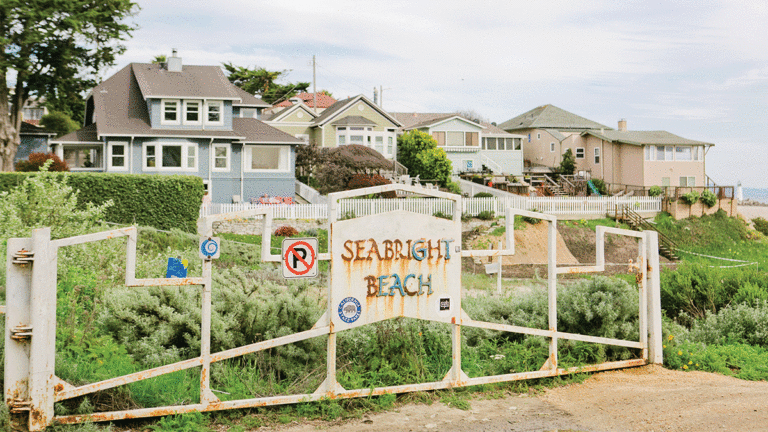
 Mom of a derby family—her husband,
Mom of a derby family—her husband,  It is known for its oceanside view of the harbor.
It is known for its oceanside view of the harbor. Founded by two UCSC students in 1973, Grey Bears delivers fresh produce and healthy staples to more than 4,000 Santa Cruz County seniors each week.
Founded by two UCSC students in 1973, Grey Bears delivers fresh produce and healthy staples to more than 4,000 Santa Cruz County seniors each week.